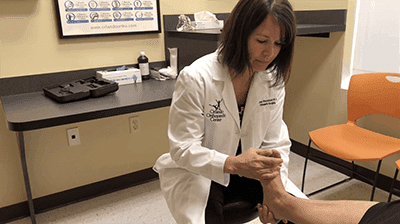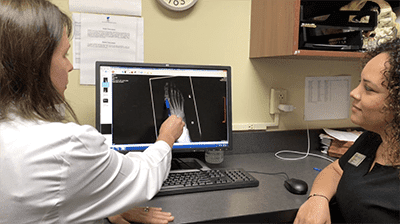What is Flat Foot Reconstruction?
- What are the symptoms of flat feet?
- Are there non-surgical treatments for flat foot?
- What are the pros and cons of flat foot reconstruction?
- What is the recovery time after flat foot reconstruction?
According to the most recent data, about 18 million people in the United States suffer from the condition known as flat feet.
Flat feet occur as the normal arch of your foot “falls,” which can occur just from normal wear and tear on your feet. What are the symptoms of flat feet and how can it be treated? Is surgery always the only option?
What Are the Symptoms of Flat Feet?
Flat feet are also called fallen arches. If you look at the bottom of the foot there is usually a natural curve on the inside between the heel and toes. The arch is formed by several ligaments and a tendon in your foot and lower leg. When the ligaments fail to do the job, that’s when the arch falls, and the condition known as flat foot occurs. Flat feet can occur for a number of reasons, including:
- A birth abnormality
- Aging
- Arthritis
- Broken or dislocated bones
- Inflammation of the tendons
- Nerve conditions
- Tendons that are stretched or torn
Obesity can contribute to the condition, as well as diabetes and aging or pregnancy.
Many times, people have flat feet, but experience no problems that require treatment. However, flat feet can cause a host of problems that do require treatment, including:
- Back and leg pain
- The feet tire quickly
- Feet that swell or become achy or itchy
Flat feet cause the whole foot to touch the floor, and can rotate the ankle inward, causing pain or swelling. These symptoms can increase with weight-bearing pressure and the person with the condition typically is unable to stand on their toes. When feet go flat it can cause many issues including difficulty walking.
Many people assume surgery is the answer in these cases, but not necessarily, according to Sophia P. Davis, D.O., an orthopaedic surgeon specializing in foot and ankle surgery at Orlando Orthopaedic Center. She says, “A lot of people believe that just because you have flat feet, you need reconstructive surgery. That’s really not the case.”
Are There Non-Surgical Treatments for Flat Foot?
 Dr. Davis points out that, “The only time you need any kind of surgery or non-operative treatment for flat feet is if you have pain. If your feet are painless you don’t need anything to make them less painful.” Some of the non-surgical options for treating flat foot include:
Dr. Davis points out that, “The only time you need any kind of surgery or non-operative treatment for flat feet is if you have pain. If your feet are painless you don’t need anything to make them less painful.” Some of the non-surgical options for treating flat foot include:
- Custom shoe inserts or even those found over-the-counter may alleviate the negative symptoms of flat feet
- A walking boot can support the ligaments and tendons in the foot, giving them time to heel
- Ice and elevation may even help, or anti-inflammatories
- Physical Thearpy
Dr. Davis confirms that, “If you do happen to have significant discomfort from having flat foot condition, there are several different treatment options. Some of them include inserts for your shoes. Others include ankle bracing which can decrease the discomfort.”
However, sometimes these treatments do not work and the patient still suffers from the condition. In these cases, Dr. Davis says, “Ultimately, if these modalities fail to adequately control your pain, then we would move on to surgical options.”
What Are the Pros and Cons of Flat Foot Reconstruction?
Every patient is different, so having a consultation with an Orthopaedic Surgeon like Dr. Davis is a critical part of your recovery and treatment plan. She describes flat foot reconstruction in this way:
“Essentially what happens when you develop a flat foot is that your heel bone goes to the outside portion of your foot and the arch collapses. Reconstructive options include shifting your heelbone over, and then doing a tendon transfer to replace the tendon that’s no longer functioning in your foot.”
There are also other options, for example, if you develop significant arthritis along with the flat foot condition. Dr. Davis describes this as a “fusion-type procedure.” She says this could include, “fusing a few of the joints in the foot, basically, positioning the foot in a good position and fusing those joints.” In this procedure, the patient still maintains foot mobility and ankle range of motion.

There are pros and cons to flat feet reconstruction. For example, the pros could include:
- Surgery is a permanent solution to solve flat feet
- It’s a low-risk high-reward medical procedure
- There is no additional treatment needed after flat foot reconstruction
- It can restore mobility and help patients resume normal life functions
Like any surgical procedure, there could be cons associated with flat foot reconstruction. For example:
- A patient could experience surgery complications, such as nerve damage or blood clots
- Patients are in a cast or boot as they recover
- The recovery time can take up to three months
Good candidates for flat foot reconstruction include:
- A diagnosis of flat feet that non-surgical interventions haven’t corrected
- Having good general health and can tolerate anesthesia
- Experiencing consistent pain
- Lifestyle changes have occurred to adapt to the condition
No matter the type of surgical intervention, Dr. Davis says, “As far as recovery period, both recovery periods would be similar.”
What is the Recovery Time After Flat Foot Reconstruction?
The biggest challenge from flat foot surgery is the healing process, however patients express how much better they feel after the procedure. Dr. Davis describes the healing journey in some detail:
“You would be in a splint for a couple of weeks until your stitches came out and then potentially in a cast or walking boot for another four to five weeks after that. Then eventually allowed to weight-bear at the six to eight-week mark, depending on how the bones were healing. Finally, coming out of the boot at about the three-month mark. We would also start some motion at the six week to eight week mark as well.”
Patients that have experienced the pain of flat feet know how debilitating it can be. In many cases, they say they didn’t realize how important their feet were, until they experienced the difficulties caused by flat feet. The good news is that there are a number of non-surgical interventions available that help many patients heal, along with effective surgeries that change people’s lives.


